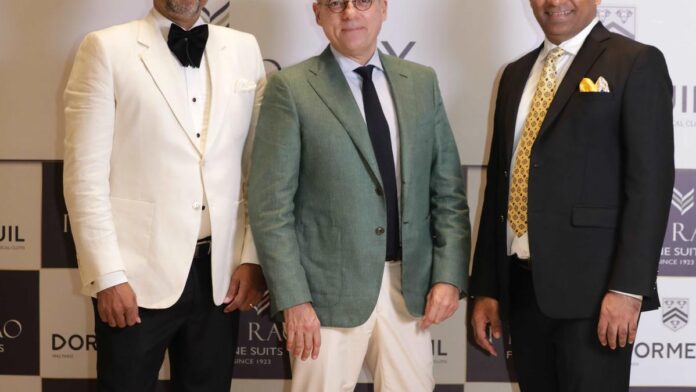William Dalrymple, in his podcast Empire, remarks that by the time the British government took over the East India Company’s operations in 1858, a cultural revolution was underway as a strong Victorian influence took over. The Englishmen in India began determining not just structure in civil society and establishing a colony, but also began influencing fashion, albeit in a condescending manner.
Toolika Gupta, a researcher who wrote a paper titledThe Impact of British Rule on the Dressing Sensibilities of Indian Aristocrats: A case study of the Maharaja of Baroda’s dress notes that it was the aristocracy, intent on pleasing their colonisers, who first made the move towards incorporating top hats, pipes and tailored suits to their repertoire. She contrasts the image of the Maharaja of Baroda — Sayajirao Gaekwad III, in an ornate brocade angrakha taken in 1919, soon moving to wearing a full English attire complete with lapels, well-structured trousers and walking sticks.
A bespoke tailoring culture that existed in the country, began making the shift towards sewing waistcoats and jackets made of wool. Years of being acquainted with this skill and perfecting the art of suit-making, is what makes India a distinct and important market for Dormeuil, the 180-year-old French textile manufacturer, says Richard Boidé, managing director of the company. “Indians know the A-Z of stitching suits by hand. There is also a desire to experiment with fabric. That is where we step in,” he says.
The managing director was in Chennai for the launch of three new fabrics — Forever Gold, Extreme Vicuna and Pashmina — as part of their luxury range. Suits designed by PN Rao, with the textile, were displayed at a fashion show in Bengaluru recently.
Richard says that their Forever Gold range — some designs with gold dust and others with gold filament — was made with an Indian customer in mind, while the Vicuna fabric, made of hair of the South American vicuña (akin to a llama), is extremely difficult to source and is hence precious. “We briefly stopped our old pashmina range because people began abusing the term ‘cashmere’. This time, we have relaunched the range with fine wool in strong yet conservative shades. This is perfect for the business traveller,” he says.
Ketan and Naveen Pishe, partners, PN Rao, say that the market in India is knowledgeable and often looks for Indian stores providing a range in terms of fabric. “India is highly celebration oriented. The colours and the fabric range is different because the clientele likes to express themselves during events, particularly weddings. Many are now looking for embellishments in their suits, particularly thread-work and stone-work,” he says.
He adds that their sport coat range and customisations to bomber jackets have been doing particularly well. Business travellers particularly prefer this.
“Lightweight, luxury fabric that is comfortable to wear in Indian weather is also preferred. Unlined is now the way to go. However, there is talent involved in making these garments. Quality hence plays a major role. Not every material is sustainable for the environment and not all suiting fabric sold in bulk looks good,” adds Naveen.
All three agree that besides making the textile and stitching the fabric, they shoulder the responsibility of educating a new audience that is intent on accessing luxury, by making clients experiment and communicate about sustainability.
“But just wait for our Spring-Summer collection. It is made for Indian parties and casual-wear, full of interesting colours,” Richard says.
Published – December 05, 2024 03:17 pm IST
#Menswear #trend #include #bespoke #suits #luxury #fabric #variety #colours #embellishments
